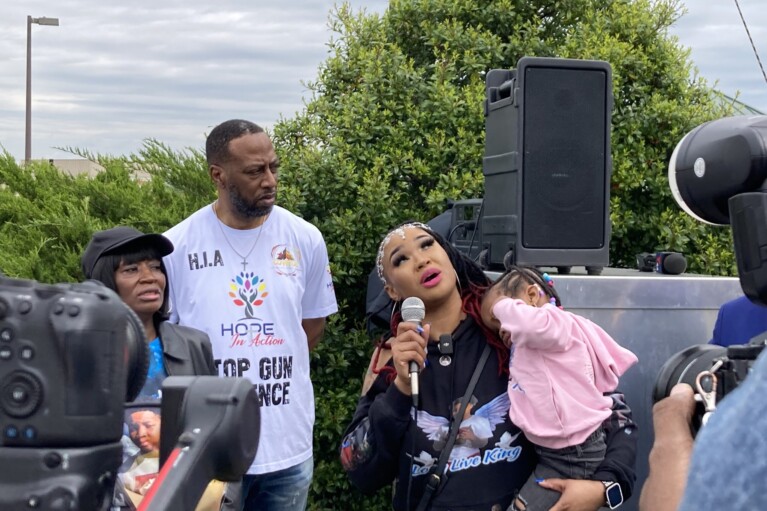Police officers can help prevent domestic violence killings by asking the right questions

For help, call 800-799-7233, or text “START” to 88788 for the 24/7 National Domestic Violence Hotline.
Last week, Andreae Lloyd’s family marked the second anniversary of her death.
Just after midnight on Dec. 7, 2021, police say, Xavier Johnson, Lloyd’s boyfriend, knocked on the door of the Miami-area group home she managed, where she was working an overnight shift alone. A surveillance camera captured what police say happened next: Johnson beat her, dragged her into his white Honda Civic and drove away.
Police say he confessed to the crime. His trial begins in January.
Intimate partner violence and domestic violence killings are a serious public health problem, according to the federal Centers for Disease Control and Prevention. But police can help prevent such killings, experts say, by using a questionnaire more states are seeking to make mandatory or more widely used during domestic violence calls.
In the wake of the well-publicized case of Gabby Petito, killed by her fiancé in 2021, Utah this spring enacted a law that requires police to conduct “lethality assessments” at domestic violence scenes.
The model lethality assessment practice, developed by the Maryland Network Against Domestic Violence, starts with an 11-question survey to determine whether a person’s life is at risk. The officer or first responder informs the victim of their screening score on the assessment and then calls a local domestic violence service hotline, connecting the hotline with the victim, if the victim is willing, to develop an immediate safety plan that might include emergency shelter.
Some Utah police already had been using lethality assessments on domestic violence calls. But since the state law went into effect, Utah has seen a sharp increase in shelter demand and referrals.
Alfreda Lyons, Lloyd’s godmother, is a domestic violence survivor herself. Her goddaughter called her an hour before she was abducted, to tell her she planned to end her relationship with Johnson. Two years later, Lyons wonders whether the death of the woman she considered a daughter could have been prevented.
“I’m a survivor because I got out. I’m a victim because my daughter was murdered,” she said. “There’s so many things I believe that you can garner from that assessment … it could be key to survival.”
Florida state Sen. Lauren Book, a Democrat, recently introduced a bill that would mandate lethality assessments in her state.
Screening tool
More than a third of the 4,970 female murder victims in 2021 were killed by an intimate partner, according to the latest statistics available from the U.S. Department of Justice. Women are five times more likely to be murdered by an intimate partner than men are, the agency said. Black and Indigenous women and rural women, according to some studies, are killed at disproportionately high rates.
More than 84% of American Indian and Alaska Native women experience violence in their lifetime, according to the Justice Department. Intimate partners are the suspects in 38% of the homicides of these women, according to a CDC analysis of data from 34 states.
The Maryland Network Against Domestic Violence first developed the model Lethality Assessment Program in 2003, with financial support from the federal Office on Violence Against Women. It is based on the Danger Assessment, a landmark screening tool developed by Johns Hopkins School of Nursing professor Jacquelyn Campbell in 1985.
The network collaborates with state and local agencies across the country to train police and domestic violence service agencies, such as shelters, to conduct the assessments.
The questions are designed to tease out facts that significantly increase the risk of homicide, such as whether the victim suffered strangulation, if their partner owns a gun or if the victim has tried to separate from their partner or leave the relationship. According to the Maryland network’s annual report, 1 in 3 domestic violence-related homicide victims in 2021 were killed while trying to end a relationship or after leaving it.
States and jurisdictions may use their own programs or different forms of lethality risk assessments, and many law enforcement agencies have been using such tools for years. The Maryland network says Connecticut, Maryland, North Carolina, Oklahoma, Pennsylvania, Virginia and Wisconsin have taken statewide approaches to implement the assessments, meaning state coordinators may require or encourage law enforcement jurisdictions to use the assessment and support them with training and resources.
Campbell and other experts say police department policies, initiated by department leaders, can be more effective than statewide mandates.
Darrell Holly, an administrator at the Maryland network, said, “When you have the buy-in from the top down, we see a more successful implementation.”
Even in states that have a law, implementation can be spotty. In a 2022 annual report released in January, the Oklahoma Domestic Violence Fatality Review Board included a recommendation to “increase law enforcement agencies’ compliance with state statute” and implement a training plan.
In North Carolina, Democratic Attorney General Josh Stein has been behind the push to roll out statewide use of lethality assessments. Stein and U.S. Rep. Deborah Ross, also a Democrat, recently held a listening session in their state, where domestic violence-related homicides have risen 25% so far in 2023 compared with 2022, Stein’s office reported in late October.
Currently, nine North Carolina jurisdictions are using the lethality assessment program, according to the attorney general’s office.
“Ultimately, it’s going to save lives,” said Skye Sullivan, director of the Family Justice Center of Alamance County, which is between Greensboro and Durham. “These numbers have steadily been going up. The biggest issue you have in trying to prevent homicide is that a lot of agencies are very siloed. A lot of systems are underfunded, and they’re understaffed.”
Services for victims
Another goal of lethality assessments is to connect victims with services such as temporary housing, mental health care or support groups that are language or culturally sensitive.
“The last place often that survivors make contact [with] are domestic violence service providers,” so being able to link them to service providers during a call is key, said Nisha Williams, legal director for the North Carolina Coalition Against Domestic Violence.
After Pitt County, North Carolina, implemented the assessment in 2012, the county saw an 82% increase in victims who received domestic violence services, according to chief sheriff’s deputy John Guard.
The National Center on Violence Against Women in the Black Community, also known as Ujima, is promoting the use of risk assessments in states where racial domestic violence disparities are widest.
Training police to use them in culturally sensitive ways is critical, said Gretta Gardner, Ujima’s chief legal officer.
For example, many Black domestic violence victims may fear coming forward because they, or their communities, have experienced discriminatory treatment by police officers and have little faith that law enforcement will protect them, she said.
In Florida, Lloyd’s family plans to send pink balloons into the sky to remember the young woman, who would have turned 30 next week.
On her desk, Lyons keeps a light-up crystal block with a laser-engraved photo of her and her goddaughter. She looks at it as she works on her dissertation about domestic violence for a doctorate in criminal justice.
“If you look at a lot of our pictures, she’s like Velcro, she’s so close to me. She’s my shadow,” Lyons said. “It saddens me that a gentle soul like Andreae had to be taken with such force and such violence by someone she loved.”



